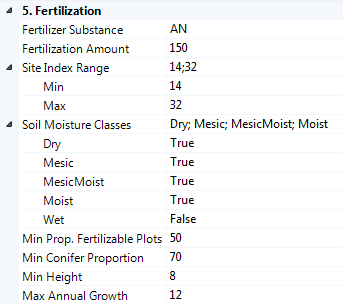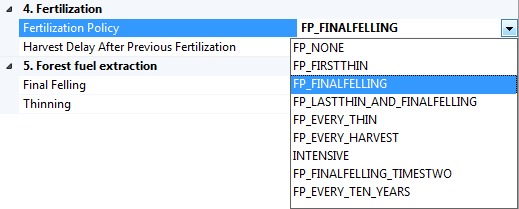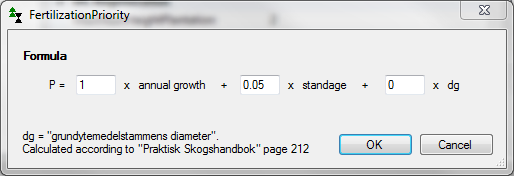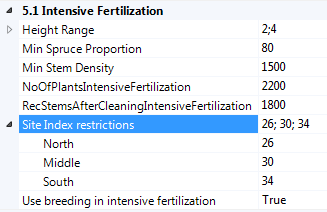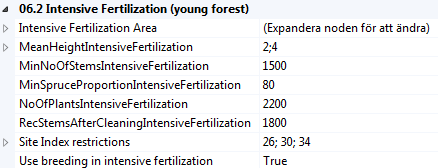Fertilization
This chapter describes the procedure for simulating fertilization, both “conventional fertilization” and intensive fertilization (often called intensive forestry). The main part of this section is devoted to conventional fertilization. intensive forestry is described further down.
Conventional fertilization is usually applied 10 years before harvest (thinning, selective cutting or final felling), or with a specified time interval (see fertilization strategy FP_EveryYenYears in PlanWise). Fertilization can thus be simulated in both clear felling forestry and continuous cover forestry.
In PlanWise and RegWise, certain settings in control tables are needed to execute fertilization. In StandWise, you click on the button “Fertilize”
Fertilization can be simulated by clicking the fertilization button or by selecting Fertilize in the Action menu.
If the function is inactivated, there are two possible reasons: either fertilization has been simulated less than two periods back, or the thinning requirements have not been met. If you hold the cursor above the Fertilize button an explanation is given. For example:
|
If you want to simulate fertilization in PlanWise, you need to select a fertilization strategy in the control table Treatment Program Generator. In addition, there are restrictions regarding where fertilization can be performed (see above). Control categories are created to apply different strategies to different types of stands or different forest generations.
Figure 3. Selection of fertilization policy in PlanWise.
Tabell 1. Available fertilization policies in PlanWise. Selection fellings are considered as thinnings.
The fertilization area can be controlled by adding restrictions in the optimization model..
|
The stand register includes a column where the last actual fertilization year (FertilizationYear) is set. Normally, recently fertilized stands will not be subjected to thinning or final felling, and you can control the number of years when there will be no harvest with the parameter Harvest Delay After Previous Fertilization. Note that this is applies to performed fertilizations. Fertilizations simulated in Heureka always forbid harvest of the stand during the following 10 years.
Start year for the analysis is assumed to be the current year. For example: A fertilization was applied in 2009, the current year is 2012 and Harvest Delay After Previous Fertilization = 10 years (default). The earliest harvest will be allowed is 2009 + 10 = 2019. The year 2019 is within period 2 if period median is used (period 0 = 2012, period 1 = 2012-2017, period 2 = 2017-2022.
|
In RegWise, you manually set the area of a domain that will be fertilized in each period under Fertilization Area. Max Annual Area in hectares is, if set, used over Max Area Proportion (which is defined as the highest proportion (%) of the potential area that will be treated, for example, 90% for fertilization area means that at most 90% of the forest area that can be fertilized will be fertilized).
You can also set how much a stand will be fertilized during a rotation (Max Amount Fertilization) and how old a stand needs to be (Max Relative Age Fertilization) relative to “optimal growth time” (1.1*LSÅ). You can also define the minimum interval between two fertilizations in a stand (Min Interval Fertilizations), and the minimum time between fertilization and the following harvest (Min Interval Treatment).
Figure 4. Fertilized area is set, in RegWise, under Fertilization Area.
Stands that will be fertilized are selected using Priority Function Fertilization.
Figure 5.
Figure 6.
|
Intensive forestry implies that a stand is fertilized from a young age (height 2-4 m) every second year, and thereafter every fifth year on several occasions until final felling. The methodology is based on the DT-model (Nilsson and Fahlvik 2006) where the growth increment in the young forest is calculated with a gain in time, and in established forests with the aid of an increased site quality index. A young forest is in this case a forest with a basal area < 25 m2/ha. At the transition between young and established forest, the age is multiplied by the time gain. Thereafter stand conditions are calculated in successive time periods with an adjusted site quality index, calculated as a function of the normal site quality index. Otherwise, existing functions are used for the prognosis.
Simulation of intensive forestry is currently only applicable for spruce forest on mesic and moist soils. Intensive forestry can only be started in young stands. It is thus not possible to start intensive fertilization in a stand with a mean height above 4 m. Tree species and site quality index demands are set in the Treatment Model control table in the Intensive Fertilization section (Figure 6).
Simulation of intensive forestry in PlanWise and StandWiseIn StandWise there is a treatment called Intensive fertilization (set via a button or the Treatment menu). Requirements for site and stand variables are set in the Treatment Model control table in a similar manner as for conventional fertilization, but in a separate section “5.1 Intensive Fertilization”.
Simulation of intensive forestry in PlanWiseIn PlanWise the fertilization strategy is set to FP_Intensive.
Figure 7. In PlanWise and StandWise, requirements for intensive forestry are set in the Intensive Fertilization section of the Treatment Model control table.
Simulation of intensive forestry in RegWiseIn RegWise, all variables are set in the Scenario Settings control table (Figure 8), not in Treatment Model. The area to be treated with intensive forestry is set in a similar way as for conventional fertilization, but under Intensive Fertilization Area.
Figure 8. In RegWise, intensive forestry requirements are set in the Intensive Fertilization section of the Scenario Settings control table.
|
The cost function for conventional fertilization has two parts, one fixed and one dependent on the amount of fertilizer. The amount depends on the amount applied per hectare and the area to be fertilized.
Fertilization costs (kr/ha) =Fertilization Fixed Cost + Fertilization Unit Cost * x * proportion of area.
where x = amount of fertilizer per hectare (Fertilization Amount, Treatment Model control table), and Proportion of area = proportion of the area to be fertilized. The fertilized area can be less than the stand area (i.e. 0<x<1) if a stand is represented by several plots and only some of them are fertilized.
Fertilization Fixed Cost and Fertilization Unit Cost settings are made in the Cost and Revenue control table:
For intensive forestry, cost per hectare and fertilization occasion are used instead.
|
The denotation for an executed fertilization is “Fertilization” (abbreviated “Fe”). The fertilization cost is presented under Total Cost in SEK per hectare.
|
See also:


